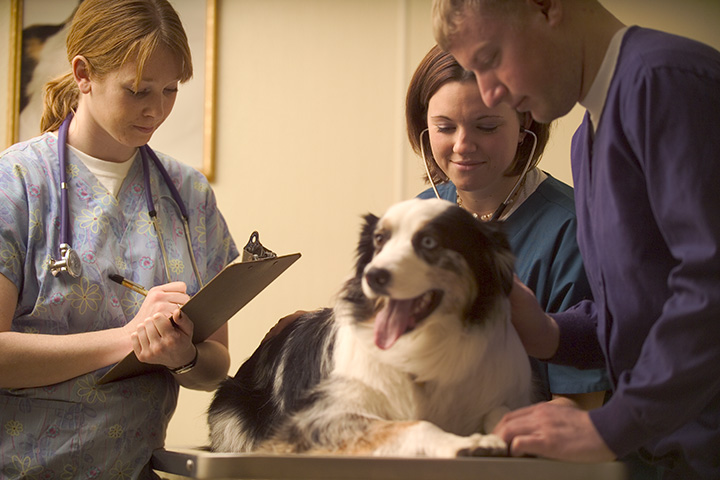Betsy Brevitz, D.V.M., author of The Complete Healthy Dog Handbook, shares 8 tips to help save money on your vet bills.
A trip to the vet can be expensive, no two ways about it. But don’t think that’s because your veterinarian is getting rich. Much of the medical equipment, supplies, and medications that we vets use is identical to that used by MDs and human hospitals, and those costs have risen tremendously over the past 10 years. Unfortunately, the prices your vet charges must increase to cover the cost of syringes, vaccines, antibiotics, blood tests, anesthesia, IV fluids, and so on.

How to Save Money on Veterinary Care
The best way is to spend wisely, on prevention rather than treatment. Here’s how to do that.
1. Spay or neuter your cats and dogs when they reach sexual maturity, while they are still young and healthy. For cats, this means at five or six months old. For dogs, this means between six months old (for small dogs) and 18 months old (for large-breed dogs). If you can’t afford the cost of surgery at a private practice, ask your local animal shelter or ASPCA where you can find a low-cost spay/neuter program.
If you put off spaying or neutering, your female cat could get pregnant, and your male cat will start spraying (marking furniture and walls with a foul-smelling secretion) and getting into fights. The result: unwanted, and preventable, expenses.
If you wait to spay your dog, her risk of accidental pregnancy, breast cancer, and pyometra, a life-threatening uterine infection, increases year by year. An unneutered male dog is on his way to developing testicular cancer, prostate cancer, or perineal hernias. All of these conditions cost much more to treat than it costs to spay or neuter a healthy young animal.
2. Use heartworm prevention and flea and tick protection as recommended for the area where you live. Yes, this will cost you $15 a month (for a small dog) and up, but if your dog gets Lyme or heartworm disease, you can count on spending hundreds to thousands of dollars on treatment in order to avoid kidney or heart failure. To me, that risk outweighs the cost of prevention.
3. Schedule annual physical exams for your animals. Yearly exams catch problems early, when they are most easily corrected or managed. One dog or cat year doesn’t equal precisely seven human years, but the basic idea is valid: way more can change in a year of their lives than in a year of ours. So get them checked out once a year.
4. Make sure that at least 75 percent of what your animals eat is a balanced dog or cat food. Treats and table food, no matter how healthy, don’t contain the appropriate vitamins and minerals and balance of protein, carbohydrates, and fat that animals need.
5. Keep your dogs and cats slim. Fat dogs are more likely to injure their backs, knees, and hips and to develop diabetes. Fat cats are more likely to develop urinary tract problems, constipation, and diabetes. None of these are easy or inexpensive to treat.
So how much food does your dog or cat need? The average dog needs about 1 cup of food per 20 pounds of ideal body weight per day. This is a standard kitchen measuring cup, not a “scoop,” and includes all food, counting edible chew treats, snacks, and table food. In other words, if your dog weighs 60 pounds but ought to weigh 40, then you should feed him 2 cups of food per day, divided between breakfast and dinner. Some dogs—I’m talking about you, “big-boned” Labrador retrievers—may need even less food than that.
An average-size cat—ideal weight 10 pounds—needs 1/2 cup of dry food or one tuna-size can of cat food or 1/4 cup of dry plus 1/2 a tuna-size can per day. Canned cat food contains more protein and less carbohydrates than dry food and so is recommended for weight loss and diabetes prevention.
Why does the dog or cat food bag tell you to feed so much more than I just did? Because it’s wrong. I’m sorry, it just is. I don’t know why, but pet food manufacturers consistently tell people to overfeed their animals.
What about exercise? For overweight animals, it doesn’t seem to be a major factor in weight loss. While playing with your cat or walking your dog more will make them happier, it’s unlikely to result in weight loss unless you reduce their food intake as well.
6. Call your vet before you treat your dog or cat with anything, even if it’s an over-the-counter medication or something prescribed for him previously. For example: Your dog is limping or seems a little out of sorts, so you decide to give him some Advil or Aleve. What’s the harm in that? Plenty. Ibuprofen (the active ingredient in Advil and Motrin) and naproxen (Aleve) are toxic to a dog’s liver and kidneys.
When you call your vet and tell her that your dog is limping and you’re thinking about giving him Drug X, she may say you should bring your dog in for an exam, but she’ll also tell you if Drug X is dangerous, and that’s good to know.
7. Always supervise animals when they’re outside. It doesn’t matter if you have a regular fence or invisible fence—other animals and people can still get into your yard and injure or be injured by your cat or dog.
8. Get advice on nutrition and medical conditions from a veterinarian, not from the guy at the pet store. He knows what the pet food and supplement salesmen have told him and what he does with his own animals. A vet’s information comes from medical school and experience treating hundreds to thousands of animals.
Healthy food, healthy weight, regular checkups—sounds very similar to what our doctors tell us, doesn’t it? Apply the same principles to your animal companions, and your vet will be delighted to see them only once a year, for their annual “well visit.”





No Comments